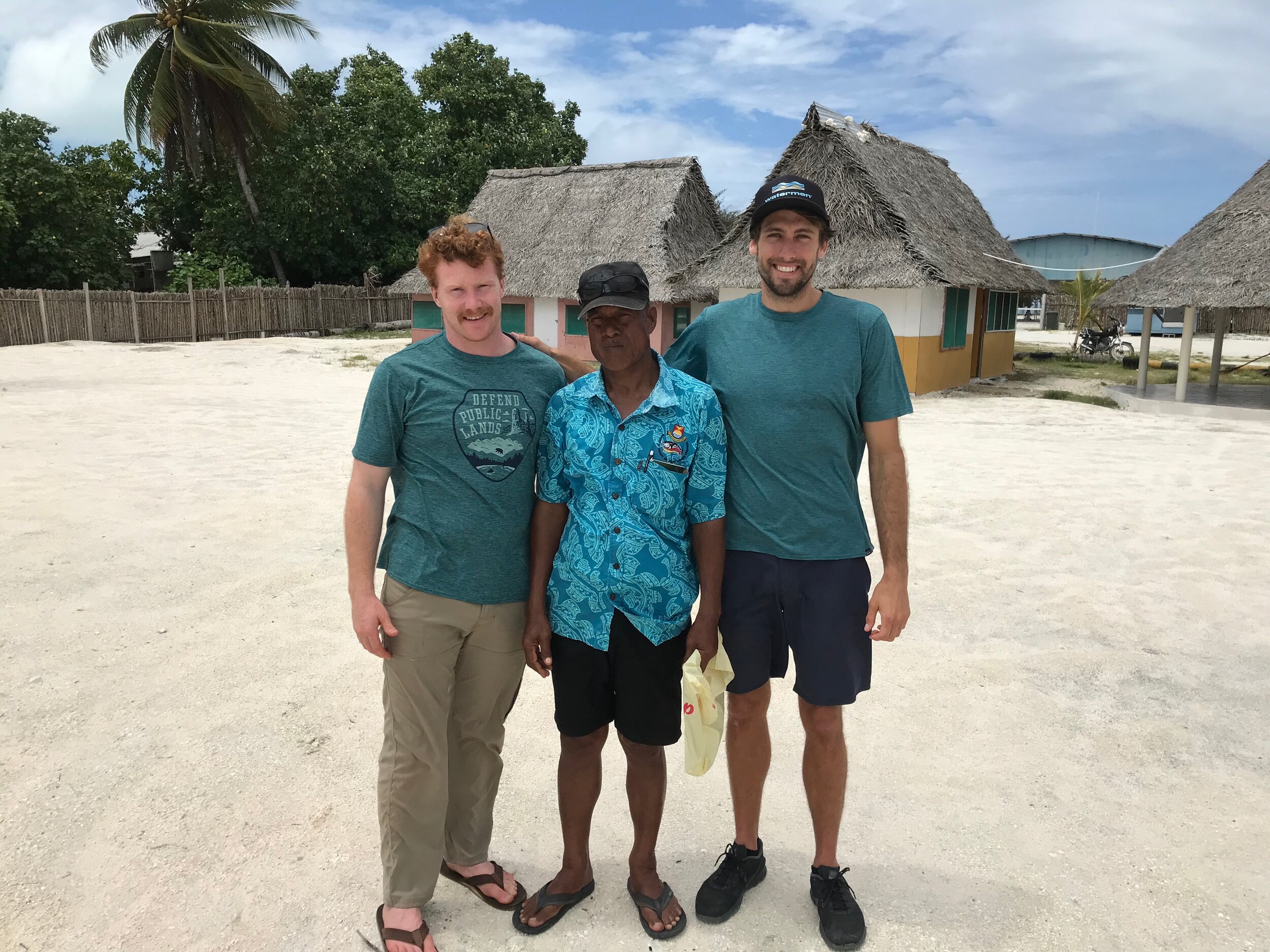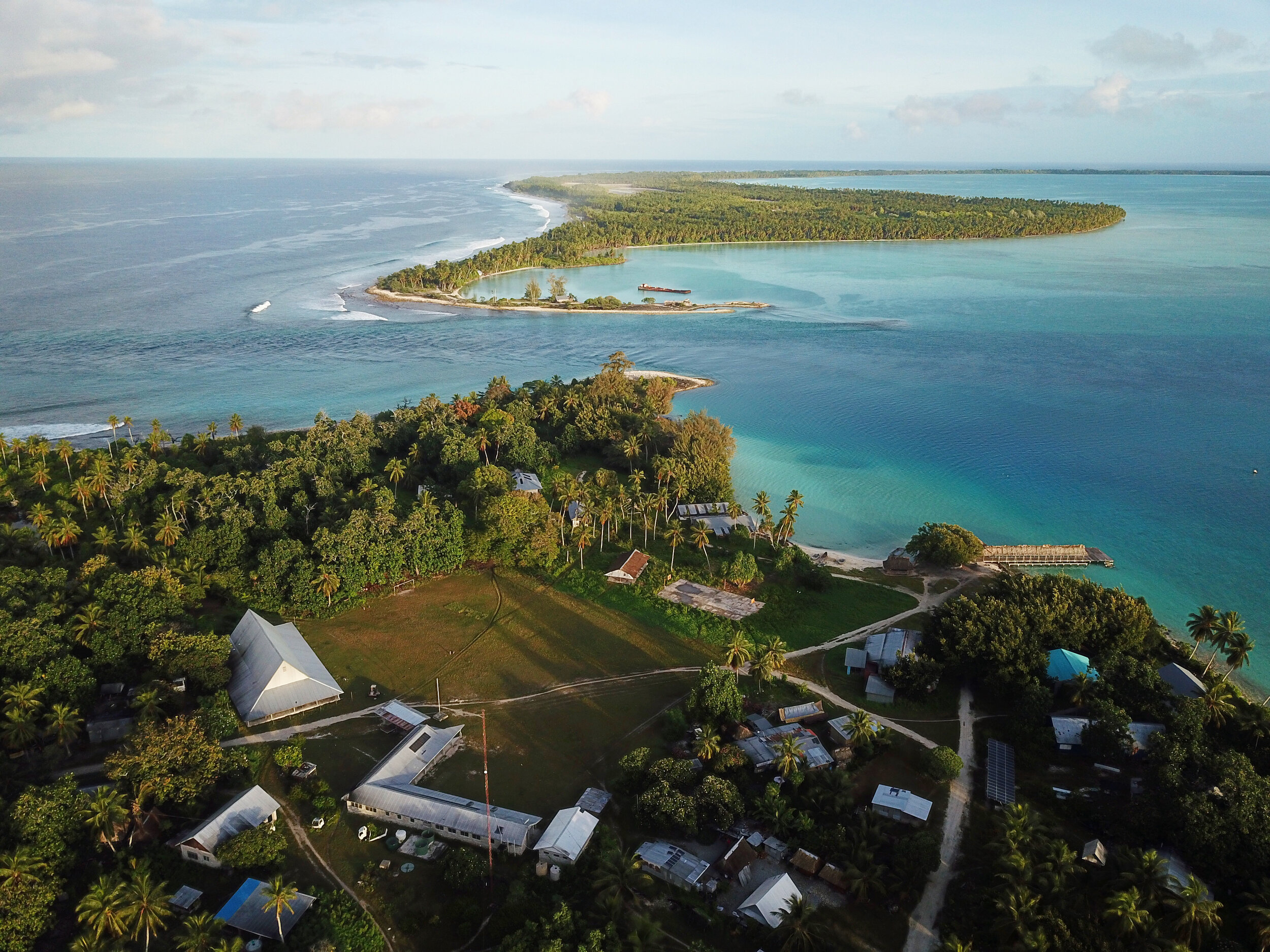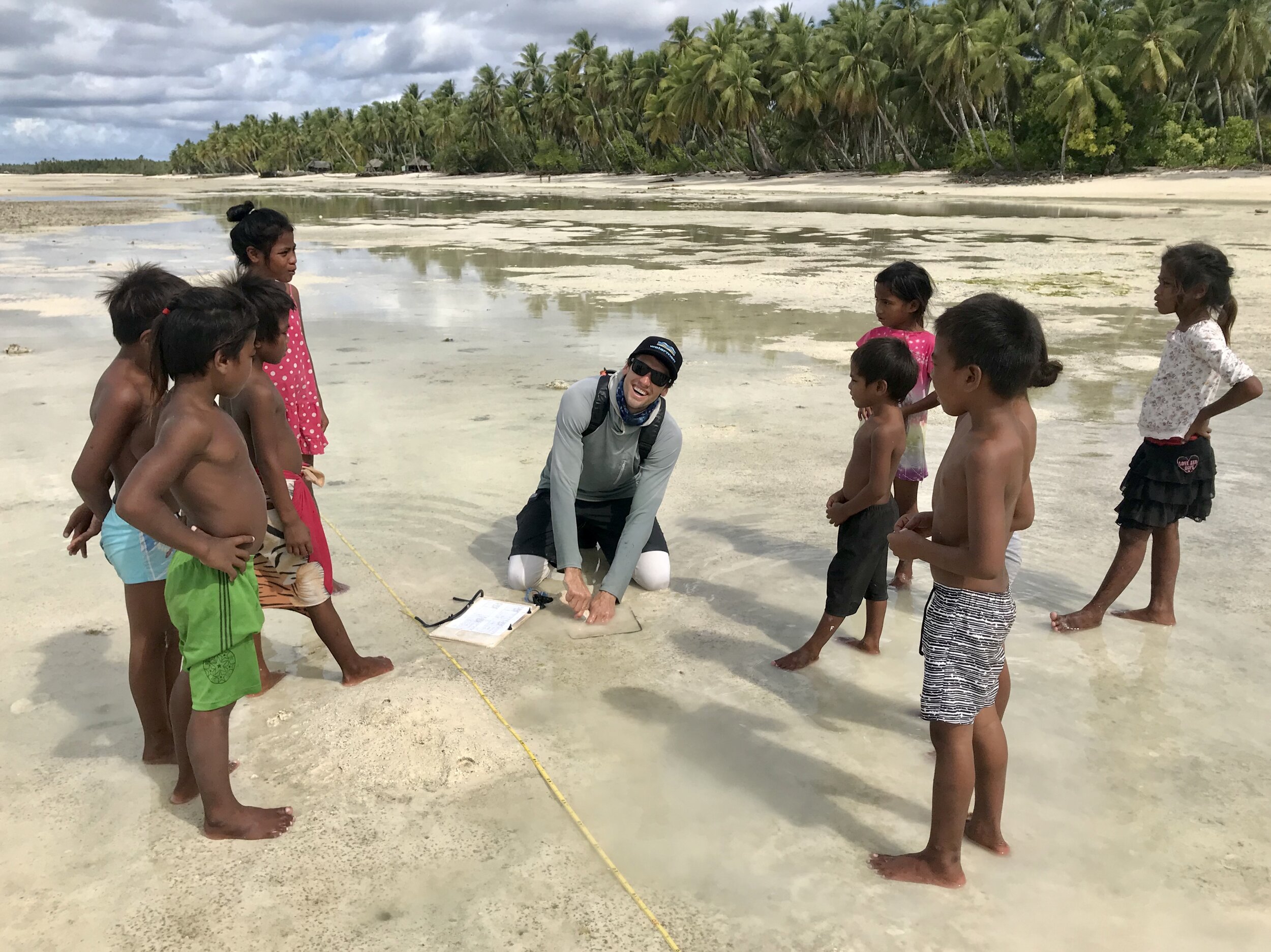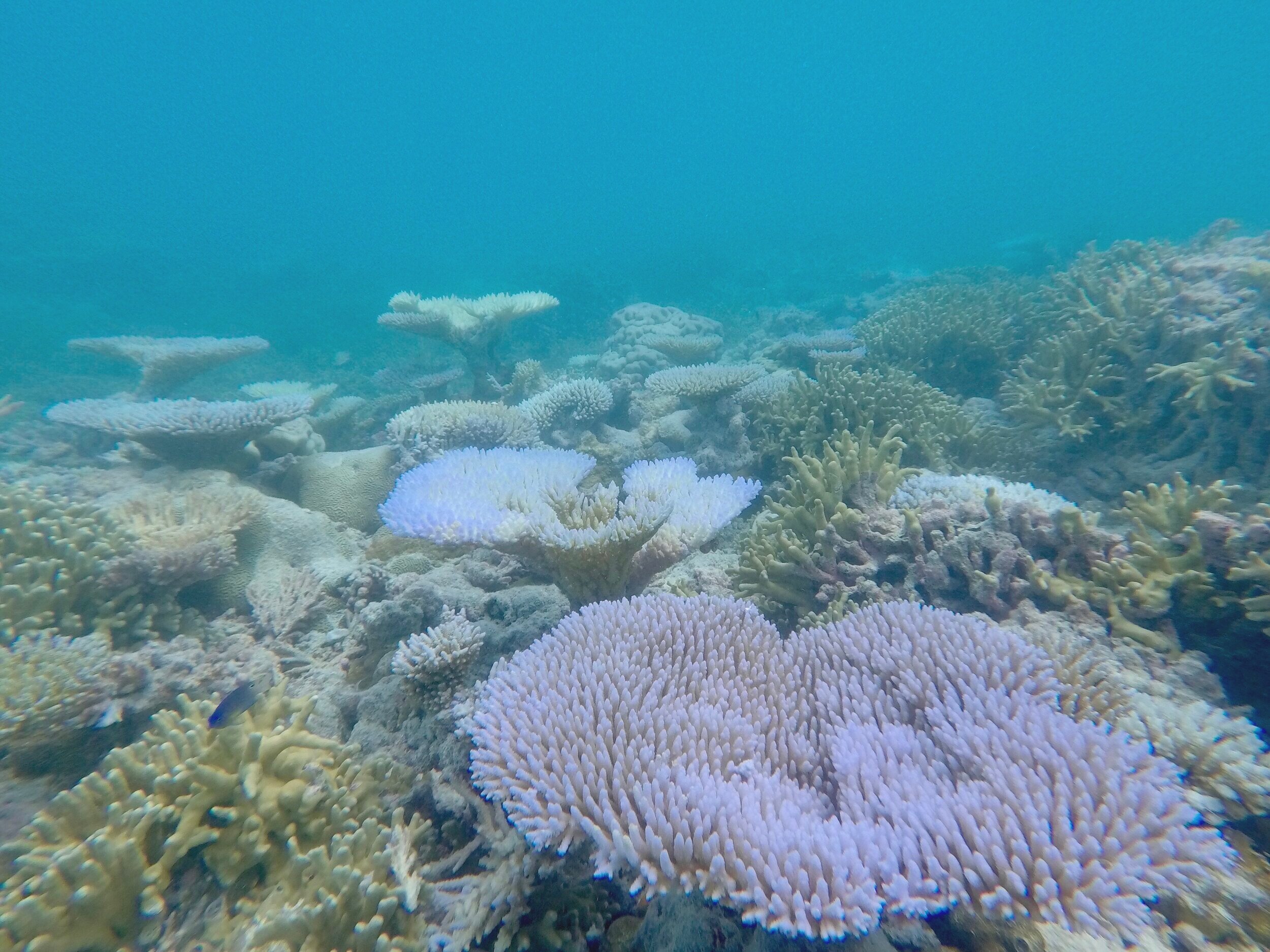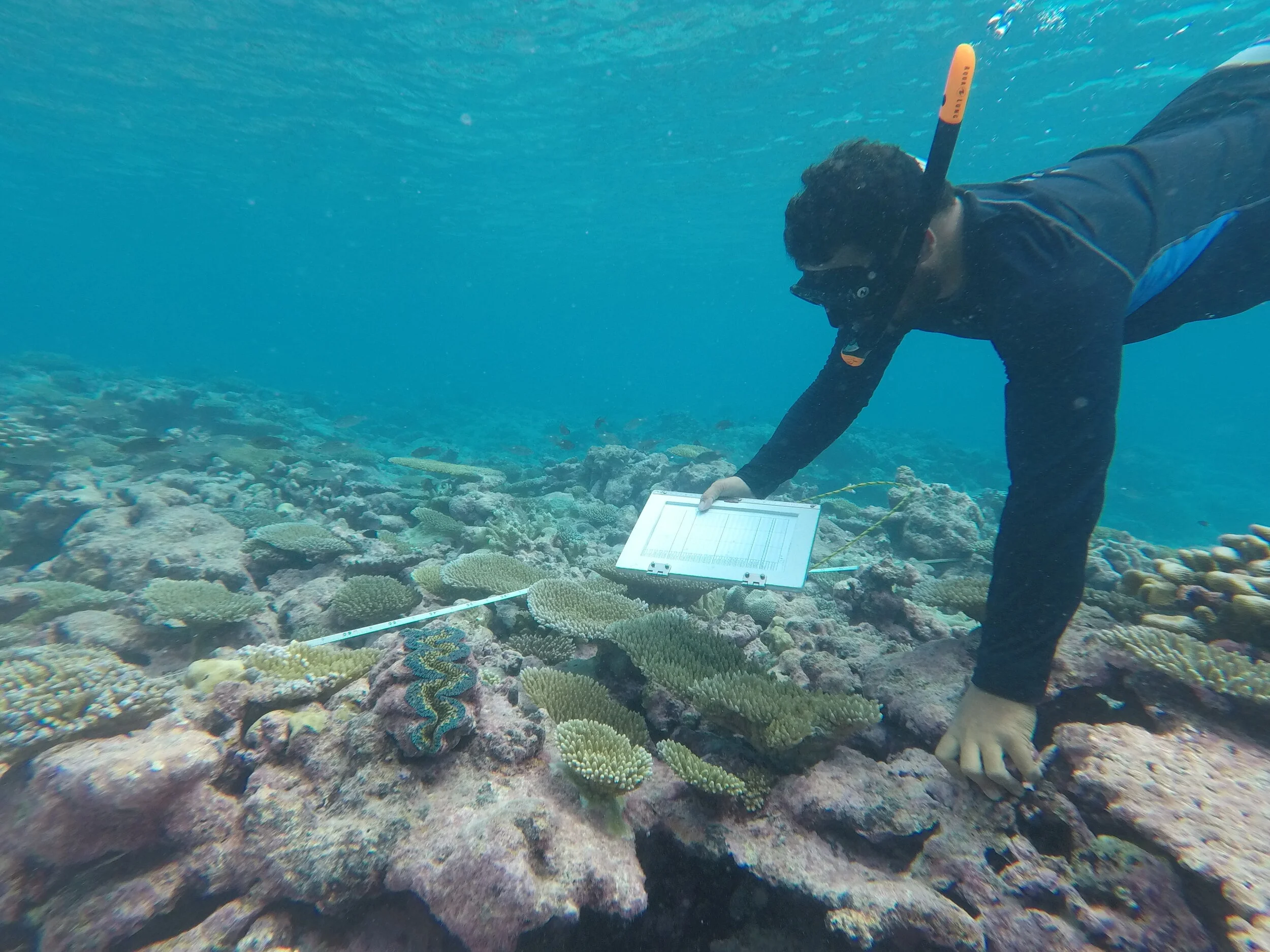
Future Expeditions
My Kiribati research is ongoing. Prospective sites for 2024 include the Gilbert Islands with current known ciguatera outbreaks (e.g., Marakei and Kuria) - based on preliminary data analysis.
All types of collaborative inquiries are welcomed. Please send me an e-mail if you would like more scientific information, contact below.
Expeditions
Kiritimati, Kiribati
February 2020
Team: Dr. Jacob Eurich, Keegan Bell, Toaea Teawatei (MFMRD), Tebatei Kourabi (MFMRD) - all pictured
Lead Organisation: Marine Science Institute, UC Santa Barbara
Partners: Kiribati MFMRD
We really enjoyed spending time at the Line Islands hub and were very lucky to make the trip - our flight was the last plane allowed into the country due to preemptive, and successful, COVID-19 restrictions. This island is our main human influence and socio-economic site for the Line Island chain, and thus was critical to our research. The team got off to a fast start at the Kiribati Ministry of Fisheries and Marine Resources Development (MFMRD) district office (pictured left). After meeting the MFMRD Director of the Line Islands, Taratau Kirata, the Interactive Dynamics of Reef Fisheries and Human Health team collected fish assemblage, invertebrate, benthic, water quality, and socio-economic data across 24 sites and 3 villages. Through the Island Council meetings we learned of a ciguatera hotspot and collected additional samples for processing with the local Department’s assistance.
Tabuaeran, Kiribati
February 2020
Team: Dr. Jacob Eurich, Keegan Bell, Toaea Teawatei (MFMRD), Tebatei Kourabi (MFMRD)
Lead Organisation: Marine Science Institute, UC Santa Barbara
Partners: Kiribati MFMRD
The Interactive Dynamics of Reef Fisheries and Human Health team arrived to the Line Islands for the first time and were greeted with fantastic weather. However, despite great conditions the team battled through inconvenient tides (swell pictured) and challenging logistics. Tabuaeran is quite remote with only one flight a week; thus, receives very few visitors and supplies. Meetings with the Island Council and local staff took time - but were extremely rewarding. Being at a new island chain, the team successfully trained two new local MFMRD members in our research protocols and sampling design. While we were unable to complete our expected sites, we finished with fish assemblage, invertebrate, benthic, water quality, and socio-economic data across 21 sites and 3 villages. We left humbled by local gifts (shark teeth weapons from subsistence fishermen, pictured mid), new knowledge, and exciting experiences. I am eager to get back!
Tabiteuea South, Kiribati
December 2019
Team: Dr. Jacob Eurich, Keegan Bell, Aranteiti Tekiau (MFMRD), Rateiti Vaimalie (MFMRD)
Lead Organisation: Marine Science Institute, UC Santa Barbara
Partners: Kiribati MFMRD
A local boat ferry away from the northern end of a long islet system sits Tabiteuea South. Despite the close proximity, Tabiteuea South is a completely different socioeconomic system with subtle differences in island geomorphology and reef community structure. As scientists, we were excited for these differences and we were not disappointed. The Interactive Dynamics of Reef Fisheries and Human Health team collected fish assemblage, invertebrate, benthic, water quality, and socio-economic data across 24 sites and 3 villages with additional ciguatera sampling at a known source location. Sample collection at the ciguatera site from local fishers is pictured (left). The team also engaged with the communities about the methods and purpose of our research (pictured mid) and learned about the important inter-island trade of giant clams (right).
Tabiteuea North, Kiribati
November 2019
Team: Dr. Jacob Eurich (pictured), Keegan Bell, Aranteiti Tekiau (MFMRD), Rateiti Vaimalie (MFMRD)
Lead Organisation: Marine Science Institute, UC Santa Barbara
Partners: Kiribati MFMRD
The Interactive Dynamics of Reef Fisheries and Human Health team was based at Tabiteuea North for two weeks and collected fish assemblage, invertebrate, benthic, water quality, and socio-economic data across 24 sites and 3 villages. Rateiti Vaimalie from MRMRD joined the team and learned our methods. She assisted with the sample collections, fisher interviews, and data processing. We spent slightly longer sampling here than other islands because the team was documenting recent coral bleaching and mortality (pictured). The Island Council was eager to learn about coral bleaching and the impacts that the event may have on their resources. Good news, the bleaching was fairly localised and was not observed on the fore-reef. It ended up being a great opportunity for local capacity building and training.
Onotoa, Kiribati
November 2019
Team: Dr. Jacob Eurich, Keegan Bell, Aranteiti Tekiau (pictured, MFMRD)
Lead Organisation: Marine Science Institute, UC Santa Barbara
Partners: Kiribati MFMRD
Our southernmost island in the Gilbert Chain. This island is certainly about as remote as it gets! One flight a week, limited to no communication, internet, or power. Despite this, Onotoa was one of our favorite islands because of the traditional and cultural experiences (pictured right) - not to mention the locals were lovely. We hit the ground running with the assistance of a lovely retired MFMRD Fisheries Officer who was managing the island’s fish center, Terruka Taaera. The Interactive Dynamics of Reef Fisheries and Human Health team collected fish assemblage, invertebrate, benthic, water quality, and socio-economic data across 24 sites and 3 villages. We also conducted sampling for ciguatera poisoning at a hot-spot upon request from the Island Mayor, Teuarai Tion.
Abemama, Kiribati
August 2019
Team: Dr. Jacob Eurich, Keegan Bell, Aranteiti Tekiau (MFMRD), Haley Barravecchia (HU) - all pictured
Lead Organisation: Marine Science Institute, UC Santa Barbara
Partners: Kiribati MFMRD, Harvard University
The Interactive Dynamics of Reef Fisheries and Human Health team collected fish assemblage, invertebrate, benthic, water quality, and socio-economic data across 24 sites and 3 villages. Upon arrival we met with the Abemama Island Council (pictured left) and learned of a ciguatera hot spot while discussing their community based fisheries management plans. Our team was able to survey the sites (pictured mid) and collect samples for later processing. We also replicated historical sites from MFMRD and hope to re-survey soon with SPC.
Butaritari, Kiribati
July 2019
Team: Dr. Jacob Eurich (pictured), Keegan Bell, Aranteiti Tekiau (MFMRD), Haley Barravecchia (HU), Eritera Aram (MFMRD) Dr. Katy Seto (UCSC), Dr. Jessica Gephart (AU)
Lead Organisation: Marine Science Institute, UC Santa Barbara
Partners: Kiribati MFMRD, Harvard University, UC Santa Cruz, American University, SPC, and University of Wollongong
Our northernmost Gilbert Island of the project and a long-term site for our fisheries management and livelihood collaborators at University of Wollongong. The Interactive Dynamics of Reef Fisheries and Human Health team collected fish assemblage, invertebrate, benthic, water quality, ciguatera, and socio-economic data across 24 sites and 3 villages. Additionally, the marine policy and fisheries trade specialists from our team visited the villages that received our social and village resource survey administered by SPC and the Kiribati Government. We learned the importance of traditional knowledge and cultural balance within their mantis shrimp fishery (pictured).
South Tarawa, Kiribati
June 2019
Team: Dr. Jacob Eurich, Keegan Bell, Aranteiti Tekiau (MFMRD)
Lead Organisation: Marine Science Institute, UC Santa Barbara
Partners: Kiribati MFMRD
It was great to spend some time in the Kiribati hub. This is our main human influence site with 51% of the countries population based at South Tarawa. Kiribati Ministry of Fisheries and Marine Resources Development (MFMRD) and all other Government affiliations are also based here. We participated in the Kiribati MFMRD’s National Coastal Fisheries Summit and were able to meet all of the Island Council’s for our prospective islands. After meetings the Interactive Dynamics of Reef Fisheries and Human Health team collected fish assemblage, invertebrate, benthic, water quality, and socio-economic data across 20 sites and 3 villages. We also were reminded many times about the South Pacific weather system (pictured).
North Tarawa, Kiribati
June 2019
Team: Dr. Jacob Eurich, Keegan Bell (pictured), Aranteiti Tekiau (MFMRD)
Lead Organisation: Marine Science Institute, UC Santa Barbara
Partners: Kiribati MFMRD
A quick ferry across the lagoon is a completely different island than its southern counterpart. We arrived and were greeted by the Mayor, offered accommodation, and got straight into the resources available, active fisheries, and past disturbances. We learned about the importance of fish traps (pictured right) when weather does not permit fishers to access the productive and easily accessible fishing grounds. The Interactive Dynamics of Reef Fisheries and Human Health team easily collected our fish assemblage, invertebrate (pictured mid), benthic, water quality, and socio-economic data across 21 sites and 3 villages. We wish we could have had more time at this island.
Abaiang, Kiribati
May 2019
Team: Dr. Jacob Eurich, Keegan Bell, Aranteiti Tekiau (pictured, MFMRD)
Lead Organisation: Marine Science Institute, UC Santa Barbara
Partners: Kiribati MFMRD
The Interactive Dynamics of Reef Fisheries and Human Health team collected our fish assemblage, invertebrate, benthic, water quality, and socio-economic data across 15 sites and 3 villages at Abaiang. This was our first island for the project’s ecological and natural systems sampling. Thus, we conducted extensive training and capacity building with MFMRD Fisheries Officers prior to data collection. We trained them on identification to species level, underwater visual census techniques, soft infaunal quadrats (pictured mid) and upgraded boating and field safety. The team also surveyed a newly established no-take clam marine protected area for baseline data (pictured left), as requested by the Mayor and Island Council.



